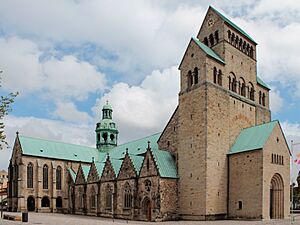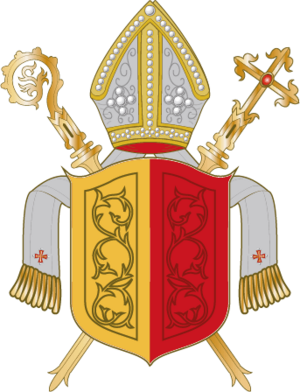Roman Catholic Diocese of Hildesheim facts for kids
Quick facts for kids Diocese of HildesheimDioecesis Hildesiensis Bistum Hildesheim |
|
|---|---|

St. Mary's Cathedral, Hildesheim
|
|

Coat of arms
|
|
| Location | |
| Country | Germany |
| Territory | Hildesheim, Lower Saxony |
| Ecclesiastical province | Hamburg |
| Statistics | |
| Area | 30,000 km2 (12,000 sq mi) |
| Population - Total - Catholics |
(as of 2013) 5,349,318 616,210 (11.5%) |
| Information | |
| Denomination | Catholic Church |
| Sui iuris church | Latin Church |
| Rite | Roman Rite |
| Established | 815 |
| Cathedral | St. Mary's Cathedral |
| Patron saint | St. Godehard Mary, Mother of God |
| Current leadership | |
| Pope | Francis |
| Bishop | Heiner Wilmer |
| Metropolitan Archbishop | Stefan Heße |
| Auxiliary Bishops | Hans-Georg Koitz (emeritus), Nikolaus Schwerdtfeger, Heinz-Gunter Bongartz |
| Map | |
 |
|
The Diocese of Hildesheim (called Dioecesis Hildesiensis in Latin) is a special area of the Catholic Church in Germany. It was started in the year 815 by King Louis the Pious. He created it to help spread Christianity. Later, his son Louis the German chose a famous leader named Ebbo to be its first bishop.
Today, the Diocese of Hildesheim covers parts of Lower Saxony state, east of the Weser River. It also includes some areas in Bremen and the city of Bremerhaven. The current bishop is Heiner Wilmer, who started his role in 2018. Since 1994, this diocese has been connected to the Archdiocese of Hamburg. Before that, it was linked to Mainz until 1805.
Contents
What is a Prince-Bishopric?
Between 1235 and 1802, the bishop of Hildesheim was not just a church leader. He was also a powerful ruler, like a prince, in the Holy Roman Empire. This special territory was called the Prince-Bishopric of Hildesheim.
How did the Prince-Bishopric stay Catholic?
In the 1500s, many parts of Germany became Protestant. Most of the Hildesheim area also changed to Protestantism. However, the bishopric managed to stay independent. This was mainly because its bishops were part of the very powerful House of Wittelsbach family from 1573 to 1761. This family helped keep the area Catholic and separate from the Protestant states around it.
How did the Diocese Area Change?
The area covered by the Hildesheim diocese stayed mostly the same until 1824. This was true even with many political changes over the years. After the wars led by Napoleon, the new Kingdom of Hanover made a deal with the Catholic Church. They agreed to make the Hildesheim diocese cover all of Hanover's land east of the Weser river.
Adding New Lands to the Diocese
The new areas added were mostly Lutheran, with only a few Catholics. These lands used to be part of other dioceses before the Reformation. These included the former Diocese of Bremen, Mainz, and Verden.
In 1827, Hanover gave some land to Bremen State for Bremerhaven. This did not change the diocese's boundaries. Then, in 1834, the Duchy of Brunswick, which was mostly Lutheran, also joined the Hildesheim diocese. This meant the diocese covered areas in three different independent states. By 1871, all these areas became part of a united German Empire.
Recent Changes to the Diocese Borders
In 1939, some suburbs of Hanover became part of Bremen city. This did not change the diocese's area. Later, in 1965, Hildesheim gave up a part of the Hoya County district to the diocese of Osnabrück. In return, Osnabrück gave Hildesheim several areas. These included Cuxhaven, Neuwerk, Scharhörn, Schaumburg-Lippe, and parts of other districts.
In 1995, Hildesheim gave its Harburg area in Hamburg to the new Archdiocese of Hamburg. This happened when the new Hamburg archdiocese was created.
Who Were the Bishops of Hildesheim?
Many bishops have led the Diocese of Hildesheim throughout its long history. Here are some of the notable leaders:
- Dietmar (1038 – 1044)
- Magnus Herzog von Sachsen-Lauenburg (1424 – 1452)
- Bernhard Herzog von Braunschweig-Lüneburg (1452 – 1458)
- Ernst Graf von Schaumberg (1458 – 1471)
- Henning von Haus (1471 – 1480)
- Berthold II of Landsberg (1481 – 1502)
- Erich Herzog von Sachsen-Lauenburg (1502 – 1504)
- John IV of Saxe-Lauenburg (1503 – 1527)
- Balthasar Merklin (1527 – 1531)
- Otto Graf von Schaumberg (1531 – 1576)
- Valentin von Tetleben (1537 – 1551)
- Friedrich Herzog von Schleswig-Holstein (1551 – 1556)
- Burchard Oberg (1557 – 1573)
- Ernst Herzog von Bayern (1573 – 1612)
- Ferdinand Herzog von Bayern (1612 – 1650)
- Max Heinrich Herzog von Bayern (1650 – 1688)
- Jobst Edmund Freiherr von Brabeck (1688 – 1702)
- Joseph Clemens Kajetan Herzog von Bayern (1714 – 1723)
- Clemens August Maria Herzog von Bayern (1724 – 1761)
- Friedrich Wilhelm Freiherr von Westphalen (1763 – 1789)
- Franz Egon Freiherr von Fürstenberg (1789 – 1825)
- Karl Klemens Reichsfreiherr von Gruben (1825 – 1827)
- Godehard Joseph Osthaus (1829 – 1835)
- Franz Ferdinand (Johann Franz) Fritz (1836 – 1840)
- Jakob Joseph Wandt (1841 – 1849)
- Eduard Jakob Wedekin (1849 – 1870)
- Daniel Wilhelm Sommerwerk (Jacobi) (1871 – 1905)
- Adolf Bertram (1906 – 1914)
- Joseph Ernst (1915 – 1928)
- Nikolaus Bares (1929 – 1933)
- Joseph Godehard Machens (1934 – 1956)
- Heinrich Maria Janssen (1957 – 1983)
- Josef Homeyer (1983 – 2004)
- Norbert Trelle (2005 – 2017)
- Heiner Wilmer (2018 – present)


